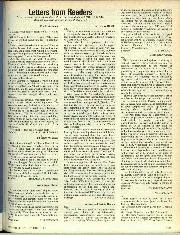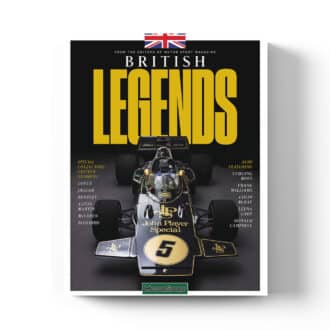
In Defence Of XR3
In Defence Of XR3 Having just read the letter by Mr. Auchterlonie in the September issue of MOTOR SPORT, I felt that I could offer some rather different reflections of…
the diffuser, and it consists of an inner tube and an outer one. In addition there are two jets of familiar type. These are indicated on the drawing as G, main jet, and J, pilot jet. The petrol level is indicated by line M, and it will be observed that this is just below the outlet of the diffuser. The main jet is submerged when the petrol is at its normal level. The pilot jet opens through a passage marked K to the throttle valve; this passage enters the body of the valve, so that it is open when the valve is practically closed. The pilot jet only is used for starting and the amount of air which enters with the fuel coming through the pilot jet is adjustable, in the customary manner, by means of the needle valve L.
It will, perhaps, be simpler if we consider the action of this carburetter under three different sets of conditions: starting and slow running being one set, acceleration another, and ordinary straight running the third.
When the first set of conditions are existing, the petrol level is normal, so that the main jet is submerged and the petrol is flowing over to the outlet of the pilot jet as well as to that of the diffuser.
On starting the engine, suction is only exerted on the pilot jet, as the throttle is practically closed and a rich mixture is drawn in the ordinary way through the pilot jet and passed into the valve L to the engine. This satisfies the conditions for slow running. Now, the Memini carburetter, which is actually the invention of a very clever Italian engineer, but is now made in this country by the Memini Carburetter Co., Ltd., whose works are at Kilburn, and who have offices at 235, High Holborn, London, W.C. 2, embodies novel, ingenious and by all accounts, successful means for overcoming the difficulties which we have described. There is still a pilot jet, a main jet, and a throttle which, as it opens relieves the pilot jet and casts the
burden of providing the mixture upon the main jet. There is, in addition, however, provision for the supply of a reserve of petrol to tide over the flat spot, and there is a patented system of balancing the suction on the “diffuser,” through which the petrol passes, from the main jet, to the choke tube, so that the undesirable enriching of the mixture, which is liable to occur when the throttle is opened, does not happen. The how and tlie why of this ingenious invention may best be understood by reference to our illustration, which has been made from a sectional drawing of the carburetter. The float chamber is seen on the right, and the mixing chamber—the choke tube—on the left. It will be noticed that the ” jet ” which projects into the choke tube is of unusual design. This ” jet ” is
Shows to Advantage when Accelerating.
When the time comes for the engine to be speeded up, the driver opens the throttle. This simultaneously, as has already been described, produces a strong suction around the diffuser and cuts off that on the pilot jet.
Now it will be understood that while the pilot jet only is working, all that space marked 1-? in the drawing, as well as the passage H and the interior of the diffuser up the line M, is full of petrol and remains so, since the pilot jet only takes a small quantity which could readily be replaced by flow through the passage from the float chamber to the underside of the main jet, and through the main jet. The presence of all this petrol is a great advantage when acceleration is required, as it provides ample fuel supplies for the diffuser and gets over the difficulty which we have described as arising, when, on the throttle being suddenly opened, the pilot jet is cut out and immediate and full demands made upon the carburetter for a rich mixture.
Now the passage through the main jet is much smaller than that through the diffuser, so that after the acceleration period is passed and the car has reached a good speed, the petrol level in the well F has dropped and the fuel only flows along the bottom of the horizontal passage H, leading from that well to the diffuser.
The Essential Feature of this Carburetter. We now come to the third set of conditions, with the car running normally at a good speed and requiring a mixture which need not be so rich as that which is desirable for starting and acceleration, and which must, moreover, be so controlled that its richness does not increase as the suction on the diffuser and main jet becomes greater. Now where there is no special provision against it, this increasing richness of the mixture would be brought about by the actual tendency of the petrol to flow more quickly, as the suction or depression on the jet becomes greater. The provision against
this happening is the novel and patented feature of the Memini Carburetter, and to understand it we must again turn our attention to the sectional drawing. It will be observed that the passage between the inner and. outer tubes of the diffuser opens its lower end into an enlarged annular chamber, which communicates, through a series of small holes C, with a passage D, which runs through the body of the carburetter, right round the choke tube, emerging into an enlarged space above the well F and connected with that well by a narrow passage E. Now but for one other provision, this arrangement would have the effect of drawing the petrol up the passage E, so that it would flow to the diffuser along D as well as along H, and in that way, we should produce the conditions which we have stated to be undesirable, that is to say, the mixture would be enriched as the suction increased. That provision is indicated on the drawing by the orifice N. This is somewhat less in area than the passage D and it opens
a connection between that passage and the atmosphere, thus considerably reducing the suction, but not eliminating it altogether. The effect may best be described as a compensating or balancing one, for it will be seen that the main suction communicating, from the choke tube, through the diffuser and the passage H, to the main jet, is balanced by another diminished in its intensity by the means we have described, and which tends to draw petrol back again out of the passage H and by the well F.
The dimensions of the orifice N, the diffuser A and the main jet G, are so calibrated as to ensure that the mixture actually passed through to the engine is, at all speeds, approximately that which is ideal.
It only remains to add that the carburetter itself is extremely accessible. Both main and pilot jets can be got at by removal of one hexagonal plug and the diffuser is just as easily removed.



